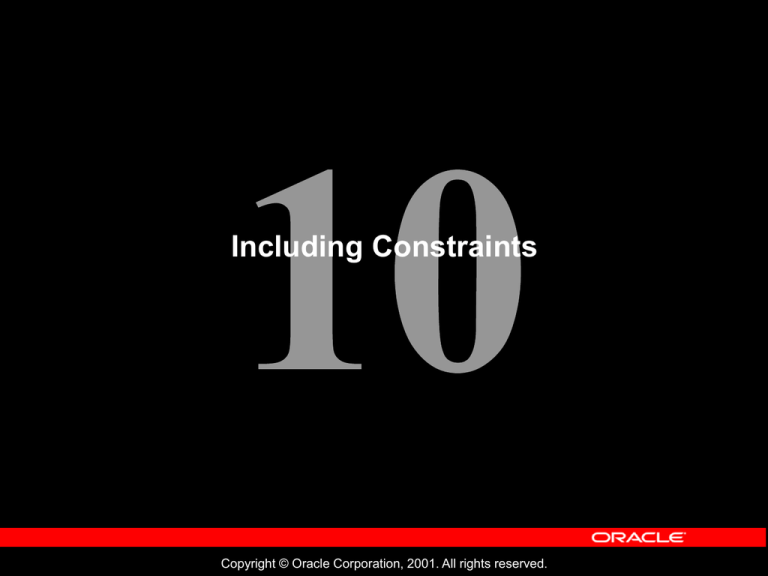
Including Constraints
Copyright © Oracle Corporation, 2001. All rights reserved.
Objectives
After completing this lesson, you should be able to
do the following:
•
•
10-2
Describe constraints
Create and maintain constraints
Copyright © Oracle Corporation, 2001. All rights reserved.
What are Constraints?
•
•
Constraints enforce rules at the table level.
•
The following constraint types are valid:
Constraints prevent the deletion of a table if there are
dependencies.
– NOT NULL
– UNIQUE
– PRIMARY KEY
– FOREIGN KEY
– CHECK
10-3
Copyright © Oracle Corporation, 2001. All rights reserved.
Constraint Guidelines
•
Name a constraint or the Oracle server generates a
name by using the SYS_Cn format.
•
Create a constraint either:
•
•
10-4
–
At the same time as the table is created, or
–
After the table has been created
Define a constraint at the column or table level.
View a constraint in the data dictionary.
Copyright © Oracle Corporation, 2001. All rights reserved.
Defining Constraints
CREATE TABLE [schema.]table
(column datatype [DEFAULT expr]
[column_constraint],
...
[table_constraint][,...]);
CREATE TABLE employees(
employee_id NUMBER(6),
first_name
VARCHAR2(20),
...
job_id
VARCHAR2(10) NOT NULL,
CONSTRAINT emp_emp_id_pk
PRIMARY KEY (EMPLOYEE_ID));
10-5
Copyright © Oracle Corporation, 2001. All rights reserved.
Defining Constraints
•
Column constraint level
column [CONSTRAINT constraint_name] constraint_type,
•
Table constraint level
column,...
[CONSTRAINT constraint_name] constraint_type
(column, ...),
10-6
Copyright © Oracle Corporation, 2001. All rights reserved.
The NOT NULL Constraint
Ensures that null values are not permitted for the
column:
…
NOT NULL constraint
(No row can contain
a null value for
this column.)
10-7
NOT NULL
constraint
Copyright © Oracle Corporation, 2001. All rights reserved.
Absence of NOT NULL
constraint
(Any row can contain
null for this column.)
The NOT NULL Constraint
Is defined at the column level:
CREATE TABLE employees(
employee_id
NUMBER(6),
last_name
VARCHAR2(25) NOT NULL,
salary
NUMBER(8,2),
commission_pct NUMBER(2,2),
hire_date
DATE
CONSTRAINT emp_hire_date_nn
NOT NULL,
...
10-8
Copyright © Oracle Corporation, 2001. All rights reserved.
System
named
User
named
The UNIQUE Constraint
UNIQUE constraint
EMPLOYEES
…
INSERT INTO
Allowed
Not allowed:
already exists
10-9
Copyright © Oracle Corporation, 2001. All rights reserved.
The UNIQUE Constraint
Defined at either the table level or the column level:
CREATE TABLE employees(
employee_id
NUMBER(6),
last_name
VARCHAR2(25) NOT NULL,
email
VARCHAR2(25),
salary
NUMBER(8,2),
commission_pct
NUMBER(2,2),
hire_date
DATE NOT NULL,
...
CONSTRAINT emp_email_uk UNIQUE(email));
10-10
Copyright © Oracle Corporation, 2001. All rights reserved.
The PRIMARY KEY Constraint
DEPARTMENTS
PRIMARY KEY
…
INSERT INTO
Not allowed
(Null value)
Not allowed
(50 already exists)
10-11
Copyright © Oracle Corporation, 2001. All rights reserved.
The PRIMARY KEY Constraint
Defined at either the table level or the column level:
CREATE TABLE
departments(
department_id
NUMBER(4),
department_name
VARCHAR2(30)
CONSTRAINT dept_name_nn NOT NULL,
manager_id
NUMBER(6),
location_id
NUMBER(4),
CONSTRAINT dept_id_pk PRIMARY KEY(department_id));
10-12
Copyright © Oracle Corporation, 2001. All rights reserved.
The FOREIGN KEY Constraint
DEPARTMENTS
PRIMARY
KEY
…
EMPLOYEES
FOREIGN
KEY
…
INSERT INTO
Not allowed
(9 does not
exist)
Allowed
10-13
Copyright © Oracle Corporation, 2001. All rights reserved.
The FOREIGN KEY Constraint
Defined at either the table level or the column level:
CREATE TABLE employees(
employee_id
NUMBER(6),
last_name
VARCHAR2(25) NOT NULL,
email
VARCHAR2(25),
salary
NUMBER(8,2),
commission_pct
NUMBER(2,2),
hire_date
DATE NOT NULL,
...
department_id
NUMBER(4),
CONSTRAINT emp_dept_fk FOREIGN KEY (department_id)
REFERENCES departments(department_id),
CONSTRAINT emp_email_uk UNIQUE(email));
10-14
Copyright © Oracle Corporation, 2001. All rights reserved.
FOREIGN KEY Constraint
Keywords
• FOREIGN KEY: Defines the column in the child
table at the table constraint level
• REFERENCES: Identifies the table and column in the
parent table
• ON DELETE CASCADE: Deletes the dependent rows
in the child table when a row in the parent table is
deleted.
• ON DELETE SET NULL: Converts dependent
foreign key values to null
10-15
Copyright © Oracle Corporation, 2001. All rights reserved.
The CHECK Constraint
•
Defines a condition that each row must satisfy
..., salary NUMBER(2)
CONSTRAINT emp_salary_min
CHECK (salary > 0),...
10-16
Copyright © Oracle Corporation, 2001. All rights reserved.
Adding a Constraint Syntax
Use the ALTER TABLE statement to:
•
Add or drop a constraint, but not modify its
structure
• Enable or disable constraints
• Add a NOT NULL constraint by using the MODIFY
clause
ALTER TABLE table
ADD [CONSTRAINT constraint] type (column);
10-17
Copyright © Oracle Corporation, 2001. All rights reserved.
Adding a Constraint
Add a FOREIGN KEY constraint to the EMPLOYEES
table indicating that a manager must already exist as
a valid employee in the EMPLOYEES table.
ALTER TABLE
employees
ADD CONSTRAINT emp_manager_fk
FOREIGN KEY(manager_id)
REFERENCES employees(employee_id);
Table altered.
10-18
Copyright © Oracle Corporation, 2001. All rights reserved.
Dropping a Constraint
•
Remove the manager constraint from the
EMPLOYEES table.
ALTER TABLE
DROP CONSTRAINT
Table altered.
•
employees
emp_manager_fk;
Remove the PRIMARY KEY constraint on the
DEPARTMENTS table and drop the associated
FOREIGN KEY constraint on the
EMPLOYEES.DEPARTMENT_ID column.
ALTER TABLE departments
DROP PRIMARY KEY CASCADE;
Table altered.
10-19
Copyright © Oracle Corporation, 2001. All rights reserved.
Disabling Constraints
•
Execute the DISABLE clause of the ALTER TABLE
statement to deactivate an integrity constraint.
•
Apply the CASCADE option to disable dependent
integrity constraints.
ALTER TABLE
DISABLE CONSTRAINT
Table altered.
10-20
employees
emp_emp_id_pk CASCADE;
Copyright © Oracle Corporation, 2001. All rights reserved.
Enabling Constraints
•
Activate an integrity constraint currently disabled
in the table definition by using the ENABLE clause.
ALTER TABLE
ENABLE CONSTRAINT
Table altered.
•
10-21
employees
emp_emp_id_pk;
A UNIQUE or PRIMARY KEY index is automatically
created if you enable a UNIQUE key or PRIMARY
KEY constraint.
Copyright © Oracle Corporation, 2001. All rights reserved.
Viewing Constraints
Query the USER_CONSTRAINTS table to view all
constraint definitions and names.
SELECT
FROM
WHERE
constraint_name, constraint_type,
search_condition
user_constraints
table_name = 'EMPLOYEES';
…
10-22
Copyright © Oracle Corporation, 2001. All rights reserved.
Viewing the Columns Associated with
Constraints
View the columns associated with the constraint
names in the USER_CONS_COLUMNS view.
SELECT
FROM
WHERE
constraint_name, column_name
user_cons_columns
table_name = 'EMPLOYEES';
…
10-23
Copyright © Oracle Corporation, 2001. All rights reserved.
Summary
In this lesson, you should have learned how to create
constraints.
•
Types of constraints:
– NOT NULL
– UNIQUE
– PRIMARY KEY
– FOREIGN KEY
– CHECK
•
10-24
You can query the USER_CONSTRAINTS table to view all
constraint definitions and names.
Copyright © Oracle Corporation, 2001. All rights reserved.





